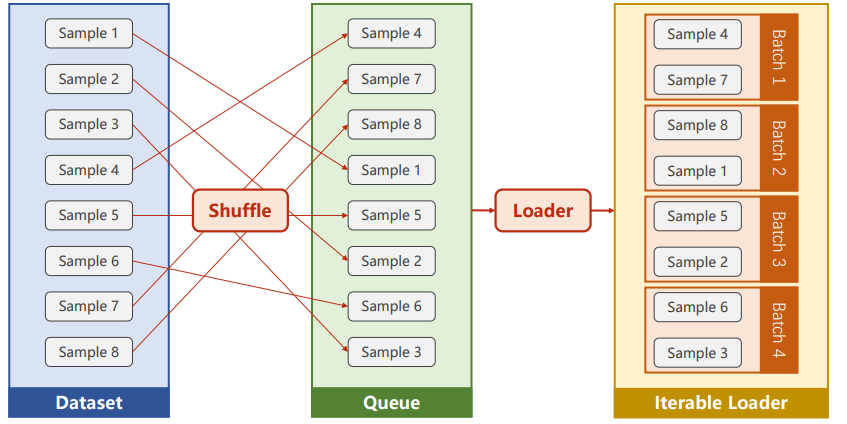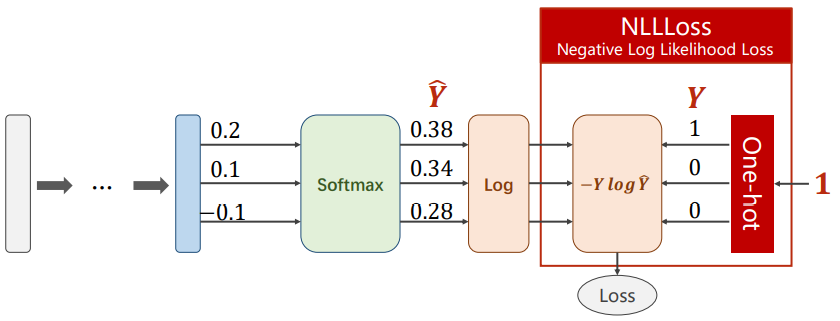Logistic回归
基本概念
Logistic回归是将实数范围映射的值到[0,1]的范围内,虽然是回归模型,但是常被用作分类任务,理解成是否属于某一类别的概率,其映射又公式称为sigmoid函数,如下:
\[\sigma(x)=\frac{1}{1+e^{-x}}\]
优化的目标函数也应该相应做出改变,改为使用交叉熵函数cross-entropy,其含义是计算两个概率分布之间的差异性 ,越小越好,具体公式展示如下:
\[H(p, q)=\sum_{i} p\left(x_{i}\right) \log \frac{1}{\log q\left(x_{i}\right)}=-\sum_{i} p\left(x_{i}\right) \log q\left(x_{i}\right)\]
在二分类问题中,具体应用如下:
\[\operatorname{los} s=-(y \log \hat{y}+(1-y) \log (1-\hat{y}))\]
代码展示
1 2 3 4 5 6 7 8 9 10 11 12 13 14 15 16 17 18 19 20 21 22 23 24 25 26 27 import torch.nn.functional as Fx_data = torch.Tensor([[1.0 ], [2.0 ], [3.0 ]]) y_data = torch.Tensor([[0 ], [0 ], [1 ]]) class LogisticRegressionModel (torch.nn.Module ): def __init__ (self ): super (LogisticRegressionModel, self).__init__() self.linear = torch.nn.Linear(1 , 1 ) def forward (self, x ): y_pred = F.sigmoid(self.linear(x)) return y_pred model = LogisticRegressionModel() criterion = torch.nn.BCELoss(size_average=False ) optimizer = torch.optim.SGD(model.parameters(), lr=0.01 ) for epoch in range (1000 ): y_pred = model(x_data) loss = criterion(y_pred, y_data) print(epoch, loss.item()) optimizer.zero_grad() loss.backward() optimizer.step()
多维特征值问题
假设输入8维,输出1维
1 2 3 4 5 6 7 8 9 10 11 12 13 14 15 16 17 18 19 class Model (torch.nn.Module ): def __init__ (self ): super (Model, self).__init__() self.linear = torch.nn.Linear(4 ,2 ) self.sigmoid = torch.nn.Sigmoid() def forward (self, x ): x1 = self.linear(x) print(x1) x2 = self.sigmoid(x1) print(x2) return x2 model = Model() x_data = torch.Tensor([[1.0 ,2.0 ,3.0 ,4.0 ],[1.5 ,2.5 ,3.5 ,4.5 ]]) y_predic = model(x_data)
结果如下:
多层神经网络
如上所示,在多层神经网络中,一般利用torch.nn.Linear 进行升维或降维,即:
将上图的神经网络实现成代码,如下所示:
1 2 3 4 5 6 7 8 9 10 11 12 13 14 15 16 17 18 19 20 21 22 23 24 25 26 27 28 29 30 31 32 33 34 35 36 37 38 39 40 41 42 43 44 import numpy as npimport torchxy = np.loadtxt('diabetes.csv.gz' , delimiter=',' , dtype=np.float32) x_data = torch.from_numpy(xy[:,:-1 ]) y_data = torch.from_numpy(xy[:, [-1 ]]) class Model (torch.nn.Module ): def __init__ (self ): super (Model, self).__init__() self.linear1 = torch.nn.Linear(8 , 6 ) self.linear2 = torch.nn.Linear(6 , 4 ) self.linear3 = torch.nn.Linear(4 , 1 ) self.sigmoid = torch.nn.Sigmoid() def forward (self, x ): x = self.sigmoid(self.linear1(x)) x = self.sigmoid(self.linear2(x)) x = self.sigmoid(self.linear3(x)) return x model = Model() for epoch in range (100 ): y_pred = model(x_data) loss = criterion(y_pred, y_data) print(epoch, loss.item()) optimizer.zero_grad() loss.backward() optimizer.step()
以上代码有两个问题:
每个epoch计算的是全部的数据,而不是mini-batch的
目前的代码均只使用了sigmoid作为激活函数
接下来我们尝试解决这两个问题:
首先,用ReLu替换sigmoid作为激活函数:
1 2 3 4 5 6 7 8 9 10 11 12 13 14 15 16 17 18 import torchclass Model (torch.nn.Module ): def __init__ (self ): super (Model, self).__init__() self.linear1 = torch.nn.Linear(8 , 6 ) self.linear2 = torch.nn.Linear(6 , 4 ) self.linear3 = torch.nn.Linear(4 , 1 ) self.relu = torch.nn.ReLU() self.sigmoid = torch.nn.Sigmoid() def forward (self, x ): x = self.relu(self.linear1(x)) x = self.relu(self.linear2(x)) x = self.sigmoid(self.linear3(x)) return x model = Model()
注意:使用ReLu时,为防止最后的输出值被用来计算ln,所以最后一层用sigmoid作为激活函数
接下来,我们研究如何利用mini-batch来加载数据集
数据加载问题
主要工具理解
主要使用Dataset和DataLoader这两个工具,其中:
Dataset:负责根据下标取出数据
DataLoader:对Dataset进行包裹,负责取出mini-batch大小的数据
涉及的概念:
iteration:表示1次迭代(也叫training step),每次迭代更新1次网络结构的参数,所需的数据量为1个batch的大小
batch-size:1次迭代所使用的样本量
epoch:1个epoch表示过了1遍训练集中的所有样本(包含多个batch的数据)
若总的数据量为1000,batch的大小为100,则每一次经过一次epoch,需要通过10次iteration
代码展示:
1 2 3 4 5 6 7 8 9 10 11 12 13 14 15 16 17 18 19 20 21 import torchfrom torch.utils.data import Datasetfrom torch.utils.data import DataLoaderclass DiabetesDataset (Dataset ): def __init__ (self ): pass def __getitem__ (self, index ): pass def __len__ (self ): pass dataset = DiabetesDataset() train_loader = DataLoader(dataset=dataset, batch_size=32 , shuffle=True , num_workers=2 )
num_workers 的含义:读取数据的并行进程的数目
对于参数shuffle 的理解:
注意:windows和linux系统上训练数据的差别,因为两个系统实现多线程的方式不同,windows使用spawn来代替fork
windows:
1 2 3 4 5 6 7 train_loader = DataLoader(dataset=dataset, batch_size=32 , shuffle=True , num_workers=2 ) …… if __name__ == '__main__' : for epoch in range (100 ): for i, data in enumerate (train_loader, 0 ): ……
linux:
1 2 3 4 5 train_loader = DataLoader(dataset=dataset, batch_size=32 , shuffle=True , num_workers=2 ) …… for epoch in range (100 ): for i, data in enumerate (train_loader, 0 ): ……
Dataset的实现(以加载全部数据为例)
1 2 3 4 5 6 7 8 9 10 11 12 13 14 15 16 17 18 19 20 21 22 23 24 25 26 27 28 29 30 31 32 33 34 class DiabetesDataset (Dataset ): def __init__ (self, filepath ): xy = np.loadtxt(filepath, delimiter=',' , dtype=np.float32) self.len = xy.shape[0 ] self.x_data = torch.from_numpy(xy[:, :-1 ]) self.y_data = torch.from_numpy(xy[:, [-1 ]]) def __getitem__ (self, index ): return self.x_data[index], self.y_data[index] def __len__ (self ): return self.len dataset = DiabetesDataset('diabetes.csv.gz' ) train_loader = DataLoader(dataset=dataset, batch_size=32 , shuffle=True , num_workers=2 ) ...... for epoch in range (100 ): for i, data in enumerate (train_loader, 0 ): inputs, labels = data y_pred = model(inputs) loss = criterion(y_pred, labels) print(epoch, i, loss.item()) optimizer.zero_grad() loss.backward() optimizer.step()
多分类问题
softmax分类器
在多分类问题中,我们期望的输出时当前数据属于各个类别的概率分布,因此我们期望它满足如下的条件:
\[P(y=i) \geq 0\]
\[\sum_{i=0}^{n} P(y=i)=1\]
因此,人们提出了如下的模型:
\[P(y=i)=\frac{e^{z_{i}}}{\sum_{j=0}^{K-1} e^{z_{j}}}, i \in\{0, \ldots, K-1\}\]
注意:在pytorch中,Cross-Entropy Loss与negative Log Likelihood Loss之间的区别
引用在pytorch论坛中看到的一句话:
If you apply Pytorch’s CrossEntropyLoss to your output layer, you get the same result as applying Pytorch’s NLLLoss to a LogSoftmax layer added after your original output layer.
对比示意图如下所示(均会自动将类别标签转化成one-hot向量):
代码验证:
1 2 3 4 5 6 7 8 9 10 11 12 13 14 15 16 17 18 19 20 import torchY = torch.LongTensor([2 , 0 , 1 ]) Y_pred1 = torch.Tensor([[0.1 , 0.2 , 0.9 ],[1.1 , 0.1 , 0.2 ],[0.2 , 2.1 , 0.1 ]]) Y_pred2 = torch.Tensor([[0.8 , 0.2 , 0.3 ],[0.2 , 0.3 , 0.5 ],[0.2 , 0.2 , 0.5 ]]) criterion1 = torch.nn.CrossEntropyLoss() l1 = criterion1(Y_pred1, Y) l2 = criterion1(Y_pred2, Y) print("Batch Loss1 = " , l1.data, "\nBatch Loss2=" , l2.data) actFunction = torch.nn.Softmax() r1 = torch.log(actFunction(Y_pred1)) r2 = torch.log(actFunction(Y_pred2)) criterion2 = torch.nn.NLLLoss() r1 = criterion2(r1, Y) r2 = criterion2(r2, Y) print("Batch Loss1 = " , r1.data, "\nBatch Loss2=" , r2.data)
结果如下:
引用
[1] 河北工业大学刘洪普老师的视频教程






